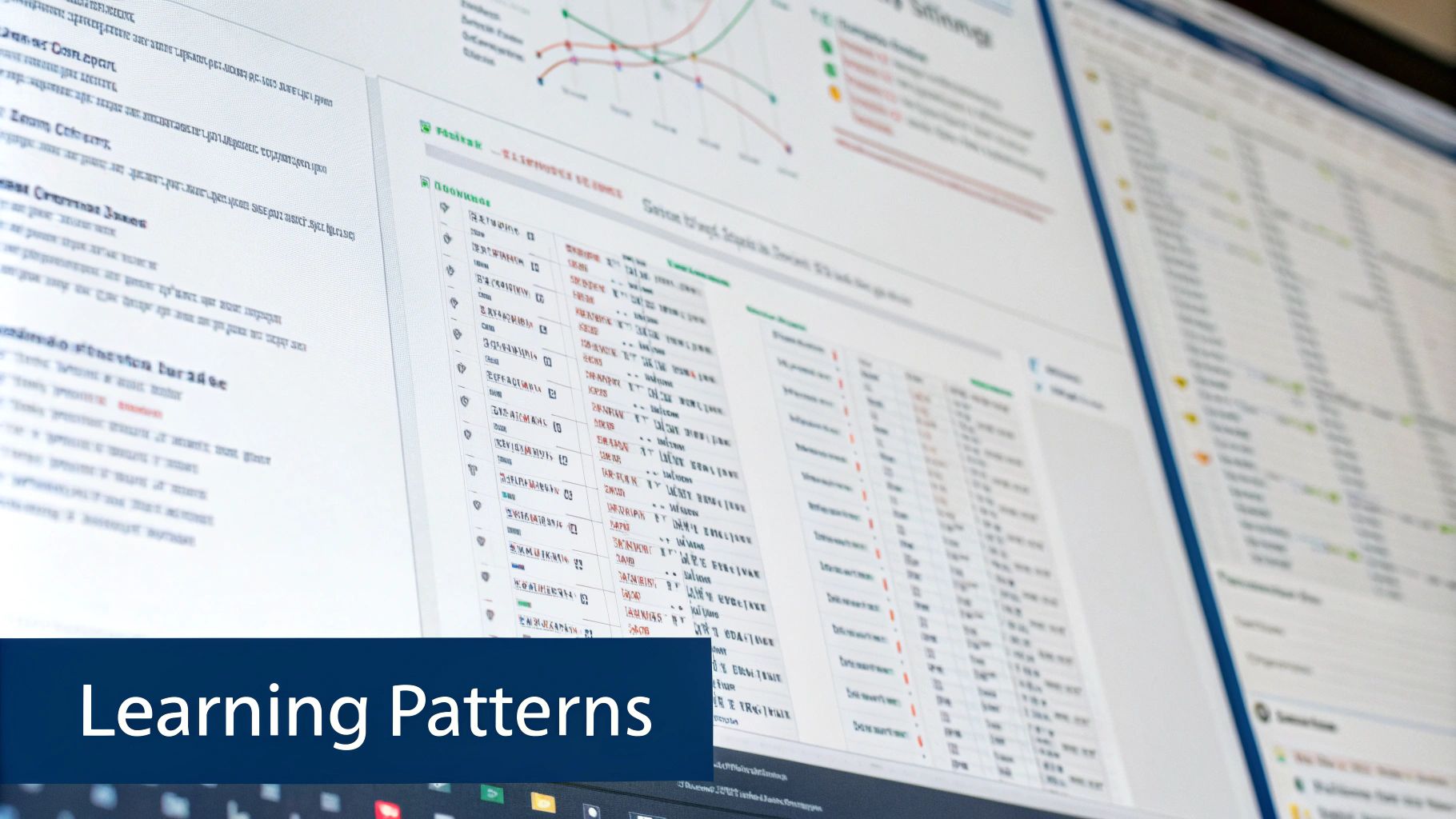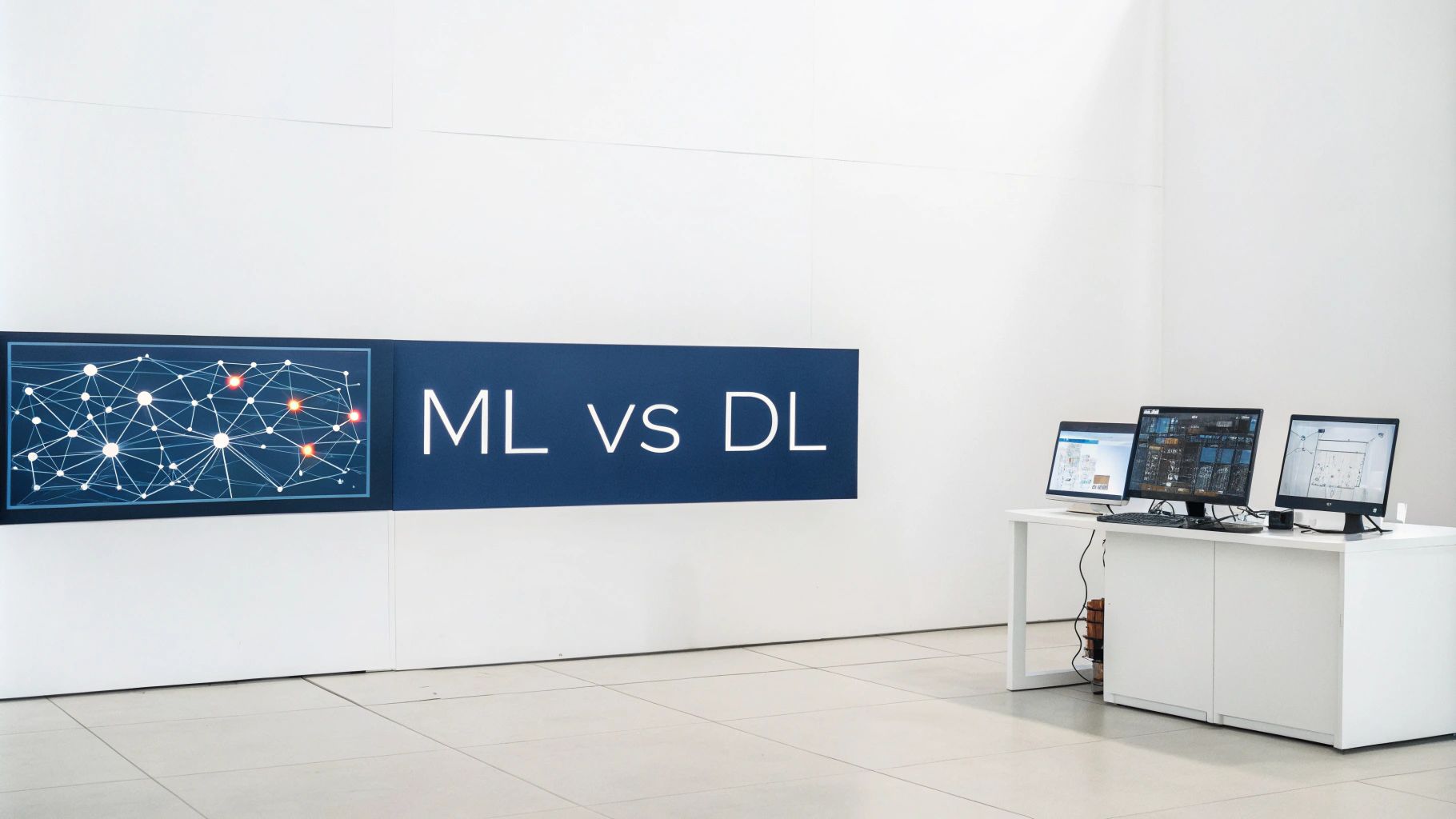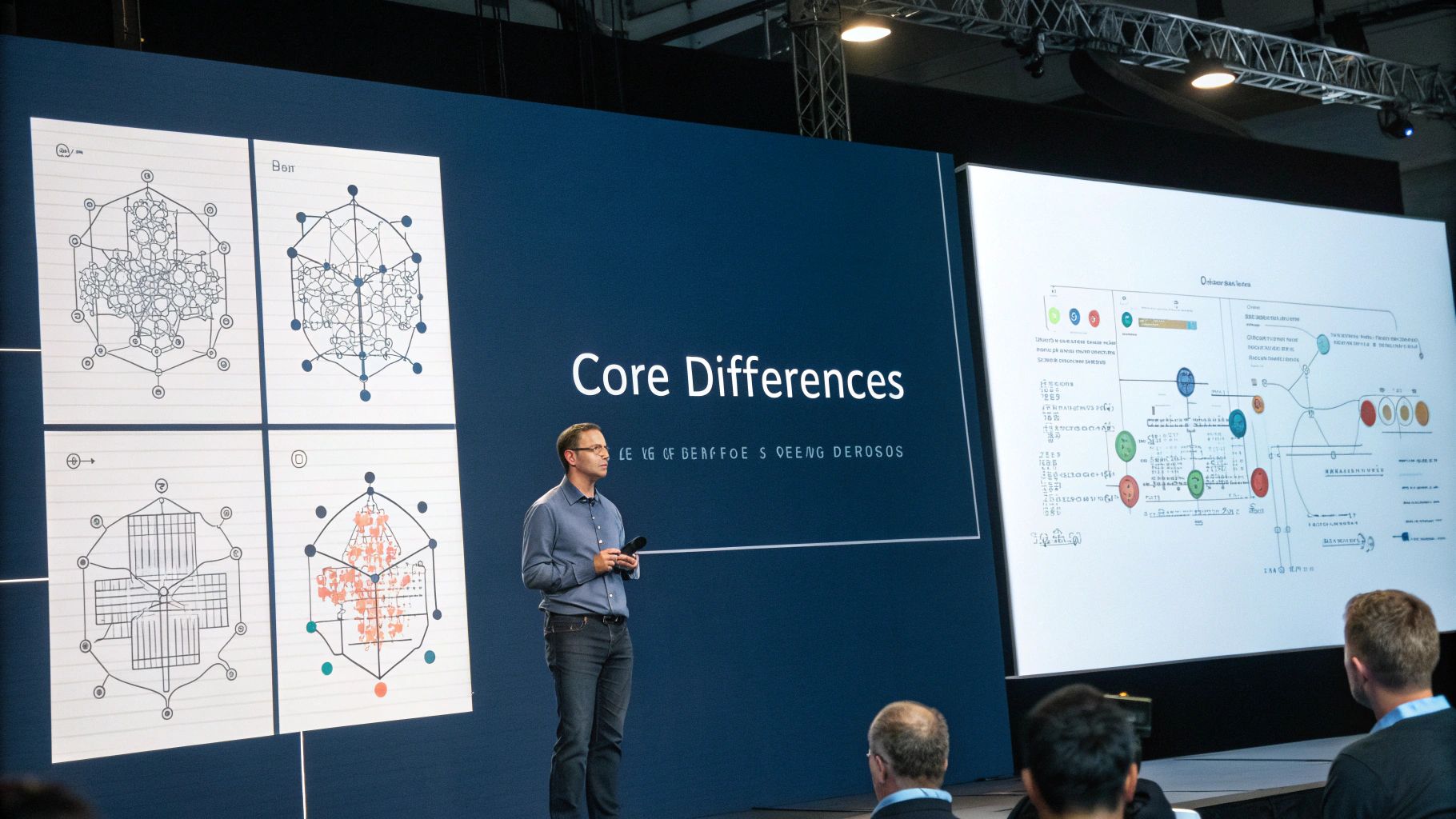Machine Learning vs. Deep Learning: Understanding the Key Differences
Introduction to ML and DL
The fields of artificial intelligence, machine learning, and deep learning are often confused. This article aims to clarify the relationship between these concepts, highlighting the nuances that distinguish machine learning from deep learning. While both are subfields of AI, their approaches, architectures, and capabilities differ significantly.
What is Machine Learning?
Machine learning allows computers to learn from data without explicit programming. This process is analogous to teaching a dog a trick: you reward it for progressively closer approximations of the desired behavior, rather than providing precise instructions. Similarly, machine learning algorithms identify patterns in data and apply these patterns to make predictions with new information. This learning can be supervised, where the algorithm learns from labeled data (like showing the dog exactly what to do), or unsupervised, where the algorithm finds patterns in unlabeled data (like letting the dog explore and figure things out on its own). For instance, a machine learning algorithm could predict housing prices based on factors like location, size, and amenities by analyzing historical market data. This predictive capability makes machine learning a powerful tool.
What is Deep Learning?
Deep learning, a specialized subset of machine learning, draws inspiration from the human brain's structure. It utilizes artificial neural networks, complex interconnected layers of algorithms, for information processing. Just as our visual system processes light through layers of retinal cells before sending information to the brain, deep learning algorithms process data through multiple layers. Each layer extracts progressively more complex features and patterns. This layered architecture is the reason for the "deep" in deep learning. As a result, deep learning can handle more complex data types, such as images and text, compared to traditional machine learning algorithms. Facial recognition software, for example, uses deep learning to analyze the intricacies of facial features within images. While these models typically require large datasets and significant computational resources, their ability to learn complex patterns makes them exceptionally powerful.
Machine Learning vs Deep Learning: A Key Distinction
A crucial difference between machine learning and deep learning is the level of human involvement. Traditional machine learning models often need careful feature engineering, meaning humans manually select and process the relevant data features for the algorithm. In contrast, deep learning models automate this process, learning features directly from the raw data. This automated feature extraction minimizes human bias and can reveal insights that manual feature selection might overlook. This fundamental difference in data processing sets the stage for understanding the unique strengths and weaknesses of each approach.
Machine Learning Fundamentals

To further distinguish between machine learning and deep learning, understanding the core principles of machine learning is essential. At their core, machine learning algorithms are mathematical models that learn patterns from data, enabling them to make predictions or decisions without explicit programming. This ability has profound implications across various fields, from finance to healthcare.
Supervised Learning: Learning with a Teacher
Supervised learning is a key category within machine learning. Imagine a teacher guiding a student through practice problems and providing feedback. In supervised learning, the algorithm learns from a labeled dataset, where each data point is linked to a specific outcome. For example, an algorithm could learn to classify images as "cat" or "dog" using a labeled image dataset. Through training, the algorithm learns to map inputs to outputs, creating a function that can generalize to unseen data.
Unsupervised Learning: Discovering Hidden Structures
Unsupervised learning, conversely, works with unlabeled data. This is similar to exploring a new city without a map: you observe patterns and connections to navigate and understand the environment. Unsupervised learning algorithms operate similarly, uncovering hidden structures and relationships in data without direct instruction. Customer segmentation, for example, can utilize unsupervised learning to group customers with similar purchasing patterns. This ability to reveal hidden insights makes unsupervised learning invaluable for exploratory data analysis.
Algorithms: The Tools of the Trade
Understanding machine learning vs deep learning also requires familiarity with the various machine learning algorithms. These algorithms are the tools driving the learning process, each possessing its own strengths and weaknesses. Commonly used algorithms include linear regression (predicting continuous outputs based on linear relationships), logistic regression (predicting categorical outputs), decision trees (building tree-like models of decisions), support vector machines (finding optimal separating hyperplanes), and k-nearest neighbors (classifying data based on neighbor similarity). Selecting the right algorithm depends on the nature of the data and the specific problem being addressed.
Data Requirements: A Key Consideration in Machine Learning vs Deep Learning
Another crucial difference between machine learning and deep learning lies in their data needs. While both require data to learn, the amount and quality play a vital role in their performance. Machine learning models often perform well with smaller datasets, typically in the thousands of examples. However, their performance tends to plateau as data increases. This is where deep learning shines. It thrives on massive datasets, potentially millions or billions of examples, allowing it to learn complex patterns and achieve higher accuracy in specific tasks. This difference in data dependence is a key differentiator when comparing the two approaches. This difference further underscores the unique nature of each method and leads into a deeper discussion of deep learning's architecture.
Deep Learning Architecture
The data dependency highlighted previously becomes even more critical when examining deep learning architecture. Deep learning distinguishes itself from traditional machine learning through its intricate structure, designed to handle the complexities of large datasets and extract subtle patterns. This architecture is based on the concept of artificial neural networks.
Artificial Neural Networks: The Building Blocks of Deep Learning
Artificial neural networks (ANNs), inspired by the biological neural networks in our brains, are the foundation of deep learning. Just as our brains process information through interconnected neurons, ANNs process data through layers of interconnected nodes. Each connection between these nodes has a weight assigned to it, indicating the strength of the connection. These weights are adjusted during the learning process, allowing the network to refine its ability to recognize patterns and make accurate predictions. This intricate network of weighted connections empowers deep learning to excel in areas where traditional machine learning often struggles, such as image recognition and natural language processing.
Layers: The Depth in Deep Learning
The power of deep learning comes from its layered structure. An ANN typically consists of an input layer, several hidden layers, and an output layer. The input layer receives the raw data, the hidden layers process and transform the data, and the output layer provides the final result. Each hidden layer extracts increasingly complex features. For instance, in image recognition, the first layer might detect edges, the second layer might recognize shapes, and subsequent layers identify more complex features like objects or faces. The more hidden layers, the "deeper" the network, and the more complex patterns it can discern. This layered approach is what allows deep learning to identify subtle nuances and complex relationships in data, leading to improved accuracy in demanding tasks like image and speech recognition and natural language processing.
How Deep Learning Learns: A Simplified Explanation
Deep learning's learning process involves adjusting the connection weights between the nodes in the network through a process called backpropagation. During training, the network makes predictions on the input data, and the error between these predictions and the actual values is calculated. Backpropagation propagates this error back through the network, modifying the connection weights to reduce future errors. This iterative process of forward propagation (making predictions) and backpropagation (adjusting weights) gradually enhances the network's accuracy. This optimization process is crucial for ensuring the model performs well with new, unseen data. It's important to remember that deep learning's power comes at a cost: it requires extensive datasets and significant computational resources, a critical factor in machine learning vs deep learning comparisons.
Key Differences
The need for substantial data and computational resources highlights the key differences between machine learning and deep learning. While both fall under the umbrella of artificial intelligence and share some common ground, their learning approach, architecture, and applications diverge significantly. Understanding these differences is vital for selecting the right tool for the task.
Data Dependence: A Defining Characteristic
A core distinction between machine learning and deep learning lies in their data requirements. Traditional machine learning algorithms often perform well with smaller datasets, sometimes as few as several thousand examples. Like teaching a child the alphabet, a relatively small number of examples are sufficient. However, their performance plateaus as data volume increases. Deep learning, in contrast, flourishes on massive datasets, often needing millions or even billions of examples to achieve peak performance. This is akin to learning a new language: fluency requires vast exposure to vocabulary and grammar. This difference stems from the complexity of deep learning models.
Architecture: Simple vs. Complex
The architectural differences are also striking. Traditional machine learning utilizes simpler algorithms, like linear regression or decision trees, comparable to a straightforward recipe. Deep learning employs complex, multi-layered artificial neural networks, akin to sophisticated machinery with numerous interacting parts. This layered architecture lets deep learning models extract hierarchical features from data, identifying patterns that simpler algorithms might miss. For instance, in image recognition, a deep learning model progressively identifies edges, shapes, and objects before classifying the entire image.
Human Intervention: Feature Engineering vs. Automated Feature Extraction
Another key difference lies in the level of human intervention. Traditional machine learning often requires extensive feature engineering, where humans manually select and transform relevant features from raw data, much like a chef preparing ingredients. Deep learning automates this feature extraction, with the neural network learning directly from the raw data, akin to a smart oven adjusting cooking settings automatically. This automated approach minimizes human bias and enables the discovery of hidden insights.
Computational Resources: Lightweight vs. Resource-Intensive
Finally, computational resource requirements are a major differentiating factor. Traditional machine learning algorithms are typically less computationally demanding, training within hours on a standard computer. Deep learning models, however, are resource-intensive, requiring powerful hardware such as GPUs and often taking days or weeks to train on large datasets. This difference in computational demands reflects the complexity of deep learning and its ability to process vast amounts of data. Therefore, while deep learning offers higher potential for complex tasks, it also requires a greater investment in computational infrastructure.
Real-world Applications
The differences between machine learning and deep learning become particularly clear when considering their real-world applications. Both have transformed various industries, but their strengths determine their optimal use cases.
Machine Learning in Action
Machine learning, with its relative simplicity and lower data requirements, is well-suited for diverse practical applications. In finance, it powers fraud detection systems by recognizing unusual transaction patterns. In e-commerce, it drives personalized product recommendations by analyzing user behavior. In healthcare, it aids in disease diagnosis and patient outcome prediction. These examples showcase machine learning's practical impact in addressing real-world challenges.
Deep Learning: Tackling Complex Challenges
Deep learning excels in situations requiring the analysis of complex, unstructured data like images, text, and audio. Its strength lies in extracting intricate patterns, making it ideal for tasks challenging for traditional machine learning. Self-driving cars rely on deep learning to process sensor data and navigate complex traffic situations. Medical imaging benefits from deep learning's ability to detect subtle anomalies in scans. Virtual assistants, like Siri and Alexa, leverage deep learning for natural language processing, understanding and responding to human speech. These advancements demonstrate deep learning's capacity to push the boundaries of artificial intelligence.
Choosing the Right Tool: Machine Learning vs Deep Learning
The choice between machine learning and deep learning depends on the problem and available resources. For problems involving structured data and smaller datasets, machine learning often offers a practical solution. However, for complex, unstructured data like images, video, or text, particularly with large datasets, deep learning's power is essential. Understanding the strengths and limitations of each approach is key to effectively harnessing the power of AI. Both fields continue to evolve, promising even more groundbreaking applications in the future.
Future Trends
The ongoing evolution of machine learning and deep learning continues to shape the future of artificial intelligence, promising transformative applications across diverse industries. Keeping abreast of these emerging trends is essential for anyone working in this rapidly evolving field.
The Rise of Explainable AI (XAI)
One significant trend is the increasing demand for explainable AI (XAI). While deep learning models often achieve remarkable accuracy, their inherent "black box" nature makes it difficult to understand their decision-making processes. This lack of transparency can hinder adoption, particularly in sensitive fields like healthcare and finance, where understanding the rationale behind a decision is crucial. XAI aims to address this by developing techniques to make deep learning models more interpretable, allowing us to understand their predictions.
Edge Computing and Federated Learning
Another important trend is the shift toward edge computing and federated learning. Traditionally, deep learning models are trained on centralized cloud servers. However, this can be problematic for applications needing real-time processing or involving sensitive data. Edge computing brings computation closer to the data source, enabling faster processing and reducing cloud dependency. Federated learning extends this by training models across multiple decentralized devices without sharing raw data. This approach allows, for example, training a keyboard prediction model on individual smartphones without uploading sensitive typing data to a server.
The Convergence of Machine Learning and Deep Learning
A growing convergence between machine learning and deep learning is also apparent. While traditionally viewed as distinct, researchers are exploring methods to combine their strengths. For example, hybrid models are being developed that utilize deep learning for feature extraction and traditional machine learning algorithms for prediction. This fusion aims to leverage deep learning's power while retaining the interpretability and efficiency of traditional machine learning. This convergence will likely blur the lines further, leading to more flexible and powerful AI solutions.
Want to stay ahead of the curve in the ever-evolving world of web development and AI? Check out DebugBar.com for the latest news, insights, and practical guides on cutting-edge technologies. Visit DebugBar.com now!



Comments
Leave a comment